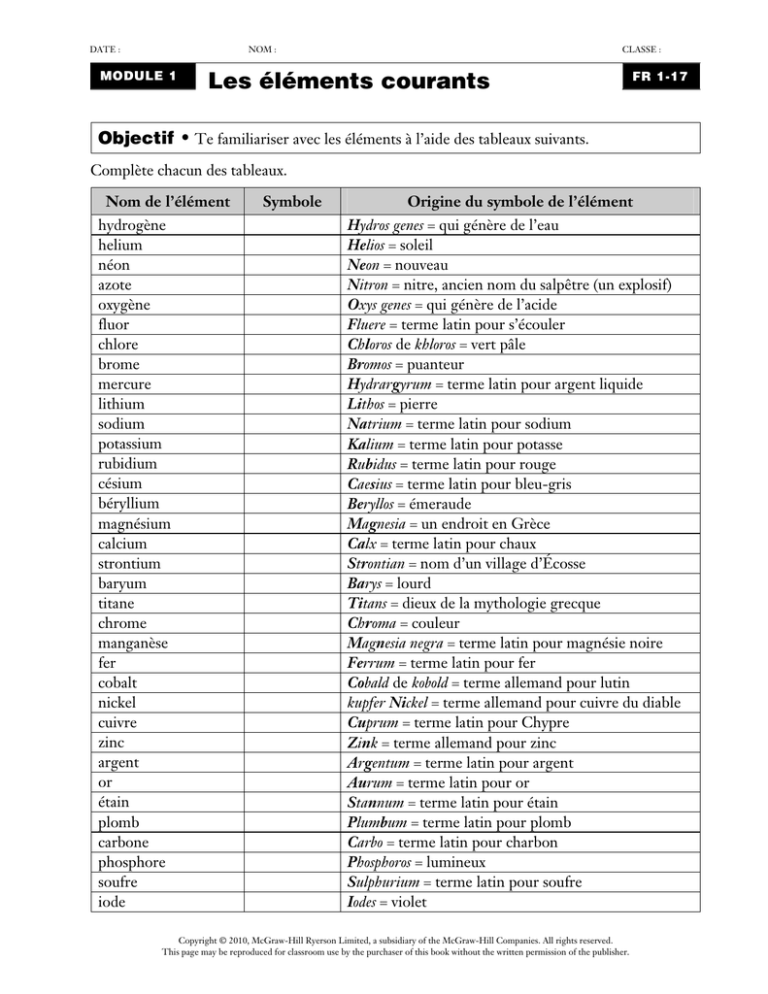Les éléments courants
publicité

DATE : NOM : MODULE 1 CLASSE : Les éléments courants FR 1-17 Objectif • Te familiariser avec les éléments à l’aide des tableaux suivants. Complète chacun des tableaux. Nom de l’élément hydrogène helium néon azote oxygène fluor chlore brome mercure lithium sodium potassium rubidium césium béryllium magnésium calcium strontium baryum titane chrome manganèse fer cobalt nickel cuivre zinc argent or étain plomb carbone phosphore soufre iode Symbole Origine du symbole de l’élément Hydros genes = qui génère de l’eau Helios = soleil Neon = nouveau Nitron = nitre, ancien nom du salpêtre (un explosif) Oxys genes = qui génère de l’acide Fluere = terme latin pour s’écouler Chloros de khloros = vert pâle Bromos = puanteur Hydrargyrum = terme latin pour argent liquide Lithos = pierre Natrium = terme latin pour sodium Kalium = terme latin pour potasse Rubidus = terme latin pour rouge Caesius = terme latin pour bleu-gris Beryllos = émeraude Magnesia = un endroit en Grèce Calx = terme latin pour chaux Strontian = nom d’un village d’Écosse Barys = lourd Titans = dieux de la mythologie grecque Chroma = couleur Magnesia negra = terme latin pour magnésie noire Ferrum = terme latin pour fer Cobald de kobold = terme allemand pour lutin kupfer Nickel = terme allemand pour cuivre du diable Cuprum = terme latin pour Chypre Zink = terme allemand pour zinc Argentum = terme latin pour argent Aurum = terme latin pour or Stannum = terme latin pour étain Plumbum = terme latin pour plomb Carbo = terme latin pour charbon Phosphoros = lumineux Sulphurium = terme latin pour soufre Iodes = violet Copyright © 2010, McGraw-Hill Ryerson Limited, a subsidiary of the McGraw-Hill Companies. All rights reserved. This page may be reproduced for classroom use by the purchaser of this book without the written permission of the publisher. DATE : NOM : CLASSE : FR 1-17 (suite) Nom de l’élément hydrogène hélium néon azote oxygène fluor chlore brome mercure lithium sodium potassium rubidium césium béryllium magnésium calcium strontium baryum titane chrome manganèse fer cobalt nickel cuivre zinc argent or étain plomb carbone phosphore soufre iode Symbole Origine du symbole de l’élément H He Ne N O F Cl Br Hg Li Na K Rb Cs Be Mg Ca Sr Ba Ti Cr Mn Fe Co Ni Cu Zn Ag Au Sn Pb C P S I Copyright © 2010, McGraw-Hill Ryerson Limited, a subsidiary of the McGraw-Hill Companies. All rights reserved. This page may be reproduced for classroom use by the purchaser of this book without the written permission of the publisher. DATE : NOM : CLASSE : FR 1-17 (suite) Symbole Nom de l’élément H He Ne N O F Cl Br Hg Li Na K Rb Cs Be Mg Ca Sr Ba Ti Cr Mn Fe Co Ni Cu Zn Ag Au Sn Pb C P S I Copyright © 2010, McGraw-Hill Ryerson Limited, a subsidiary of the McGraw-Hill Companies. All rights reserved. This page may be reproduced for classroom use by the purchaser of this book without the written permission of the publisher. DATE : NOM : CLASSE : FR 1-17 (suite) Nom de l’élément Symbole Origine du symbole de l’élément hydrogène hélium néon azote oxygène fluor chlore brome mercure lithium sodium potassium rubidium césium béryllium magnésium calcium strontium baryum titane chrome manganèse fer cobalt nickel cuivre zinc argent or étain plomb carbone phosphore soufre iode Copyright © 2010, McGraw-Hill Ryerson Limited, a subsidiary of the McGraw-Hill Companies. All rights reserved. This page may be reproduced for classroom use by the purchaser of this book without the written permission of the publisher.